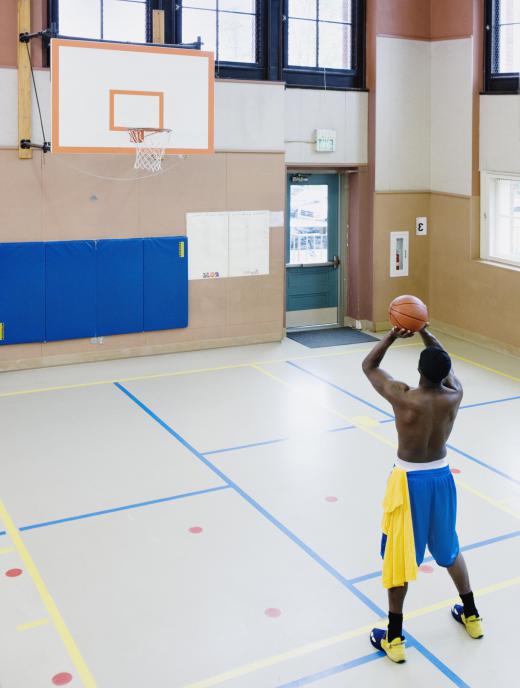The dimensions of a basketball court can vary depending on factors such as the level of basketball that is played on it or, in some cases, the space that is available. Courts used in organized leagues typically are a standard size based on the rules of those leagues. Basketball courts in buildings such as elementary schools, community centers and churches often are smaller than a standard size, especially in older buildings. Outdoor courts used for recreational basketball vary even more in size and often are only half-courts. Most full-size courts are 70 to 94 feet (21.34 to 28.65 m) long and 40 to 50 feet (12.19 to 15.24 m) wide, with the length-to-width ratio usually a little less than 2-to-1.
Other important basketball court dimensions include the height of the rim, the distance to the free-throw line, the width of an area near the basket called the key, and the distance to the 3-point arc. The rim of the hoop is 18 inches (45.72 cm) in diameter and attached to a backboard. Except on courts designed for youth basketball, the rim of the basket is always 10 feet (3.05 m) high. For youths, the rim is lower, with the exact height varying according to the ages of the players. All of the other basketball court dimensions typically vary depending on the rules of the league or organization.
American Professional Leagues

In the National Basketball Association (NBA) and Women's National Basketball Association (WNBA), the North American professional leagues for men and women, respectively, most of the basketball court dimensions are the same. The court itself is 94 feet (28.65 m) long and 50 feet (15.24 m) wide. The free-throw line is 15 feet (4.57 m) from the backboard, and the key — the area from the free-throw line to the court's end line — is 16 feet (4.88 m) wide.

One of the few differences between the NBA and WNBA courts is the distance to the 3-point arc. In the WNBA, it is 20 feet, 6.25 inches (6.25 m) from the center of the basket. The 3-point line in the NBA is 22 feet (6.71 m) from the basket on the sides of the court and 23 feet, 9 inches (7.24 m) at the top of the key. The NBA 3-point distance is less on the sides to give players at least 3 feet (0.91 m) of room between the 3-point line and the side of the court. Therefore, the line goes straight out from the baseline until it meets what would be a full arc 23 feet, 9 inches (7.24 m) from the basket, at which point it takes a semicircular shape until it straightens out again 3 feet (0.91 m) from the other sideline.
International Basketball Federation

Under the rules of the International Basketball Federation (FIBA), which governs most levels of professional and amateur basketball outside of North America and some events in North America, most of the basketball court dimensions are based on the metric system. One exception is the height of the basket, which is 10 feet (3.05 m). Standard FIBA courts are 91 feet, 10.36 inches (28 m) long and 49 feet, 23.55 inches (15 m) long. The free-throw line is 15 feet, 1.11 inches (4.6 m) from the backboard, and the key is 16 feet, 0.9 inches (4.9 m) wide. Before October 2010, FIBA used a trapezoidal key that was wider at the baseline and narrower at the free-throw line.

Another change FIBA made in 2010 was to move the 3-point line back. Before this rule change, it had been at a distance of 20 feet, 6.25 inches (6.25 m) since 1984. When the rule was implemented, the FIBA 3-point line took on a shape similar to that in the NBA, with straight lines on the sides and an arc across the top. The distance is 21 feet, 7.84 inches (6.6 m) from the center of the basket on each side and 22 feet, 1.75 inches (6.75 m) at the top.
Colleges and High Schools

For colleges and high schools in the United States, the basketball court dimensions are mostly the same of those used in the NBA. The main exception is the distance to the 3-point line: 20 feet, 9 inches (6.32 m) for colleges and 19 feet, 9 inches (6.02 m) for high schools. Also, the key is only 12 feet (3.66 m) wide.
